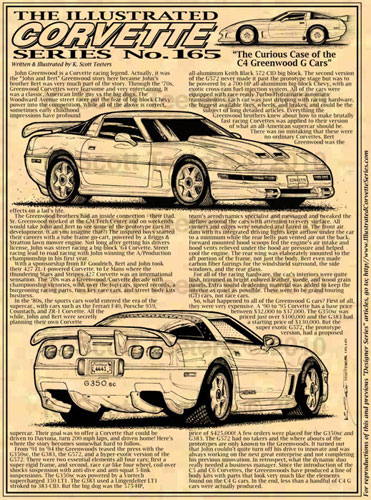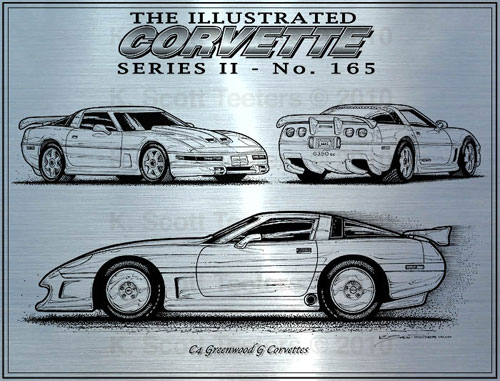John & Burt Greenwood Build Super C4 Corvettes

John Greenwood is a Corvette racing legend. Actually, it was the “John and Bert” Greenwood story here because John’s brother Bert was very much part of the story. Through the ‘70s, Greenwood Corvettes were fearsome and very entertaining. It was a classic, American little guy vs the big dogs. The Woodward Avenue street racer put the fear of big-block Chevy power into the competition. While all of the above is correct, sometimes early childhood impressions have profound effects on a lad’s life.
The Greenwood brothers had an inside connection – their Dad. Sr. Greenwood worked at the GM Tech Center and on weekends would take John and Bert to see some of the prototype cars in development. (Can you imagine that?) The inspired boys started their careers with a tube frame go-cart, powered by a Briggs & Stratton lawn mower engine. Not long after getting his drivers license, John was street racing a big-block ‘64 Corvette. Street racing lead to road racing with John winning the A/Production championship in his first year.

With a sponsorship from BF Goodrich, Bert and John took their 427 ZL-1-powered Corvette. to Le Mans where the thundering Stars and Stripes 427 Corvette was an international sensation. The ‘70s was a Greenwood/Corvette decade with championship victories, wild, over the top cars, speed records, a burgeoning racing parts, turn key race cars, and street body kits business.
In the ‘80s, the sports cars world entered the era of the supercar., with cars such as the Ferrari F40, Porsche 959, Countach, and ZR-1 Corvette. All the while, John and Bert were secretly planning their own Corvette supercar. Their goal was to offer a Corvette that could be driven to Daytona, turn 200-mph laps, and driven home! Here’s where the story becomes somewhat hard to follow.
From ‘91 to ‘94 the Greenwoods teased the press with the G350sc, the G383, the G572, and a hyper-exotic version of the G572. There were two essential elements all four cars; first a super-rigid frame, and second, race car-like four wheel, coil-over shocks suspension with anti-dive and anti-squat 5-link suspensions. The G350sc was powered by a Vortech supercharged 350 LT1. The G383 used a Lingenfelter LT1 stroked to 383-CID. But the big dog was the 575-HP, all-aluminum Keith Black 572-CID big block. The second version of the G572 never made it past the prototype stage but was to be powered by a 700-HP all-aluminum big-block Chevy, with an exotic cross-ram fuel-injection system. All of the cars were equipped with race-ready Turbo-Hydramatic automatic transmissions. Each car was just dripping with racing hardware, the biggest available tires, wheels, and brakes, and could be the subject of long detailed articles. Everything the Greenwood brothers knew about how to make brutally fast racing Corvettes was applied to their version of what an all-American supercar should be.
There was no mistaking that these were no ordinary Corvettes. Bert Greenwood was the team’s aerodynamics specialist and messaged and tweaked the airflow around the cars with attention to every surface. All corners and edges were rounded and faired in. The front air dam with its integrated driving lights kept airflow under the car to a minimum while the rear belly pan vented air out the back. Forward mounted hood scoops fed the engine’s air intake and hood vents relieved under the hood air pressure and helped cool the engine. The rear wing was elaborately mounted to the aft portion of the frame, not just the body. Bert even made carbon fiber fairings for the windshield surround, the side windows, and the rear glass.
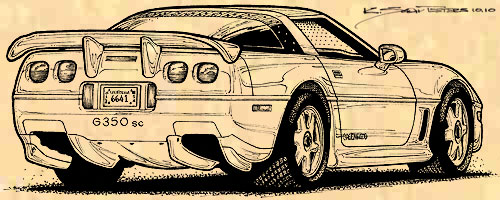
For all of the racing hardware, the car’s interiors were quite lush, trimmed in bright colored leather, suede, and wood grain panels. Extra sound deadening material was added to keep the interior as quiet as possible. These were to be grand touring (GT) cars, not race cars.
So, what happened to all of the Greenwood G cars? First of all, they were very expensive. A ‘90 to ‘95 Corvette has a base price between $32,000 to $37,000. The G350sc was priced just over $100,000 and the G383 had a starting price of $130,000. But the super exotic G572, the prototype version, had a proposed price of $425,000! A few orders were placed for the G350sc and G383. The G572 had no takers and the where abouts of the prototypes are only known to the Greenwoods. It turned out that John couldn’t quite turn off his drive to innovate and was always working on the next great enterprise and not completing his previous innovation. In retrospect, what the dynamic duo really needed a business manager. Since the introduction of the C5 and C6 Corvettes, the Greeenwoods have produced a line of body kits with parts that look very much like the elements found on the C4 G cars. In the end, less than a handful of C4 G cars were actually produced. – KST
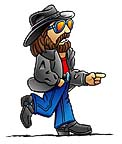
PS – Here’s a slide show of images of the real cars
[nggallery id=7]
PSS – 11×17 parchment paper prints and Laser-Etched prints of the Greenwood C4 G-Corvettes are available HERE.
or, just click any of the below images.
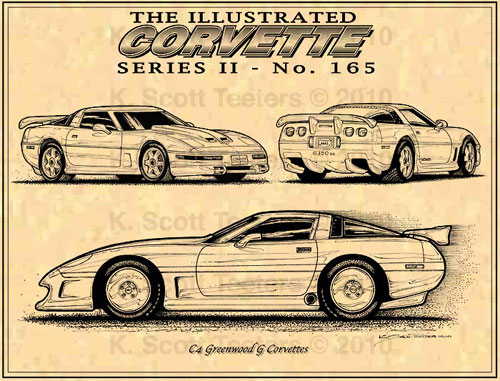
Illustrated Corvette Series-II No. 165 Greenwood C4 G-Corvette
Illustrated Corvette Series No. 165 Greenwood C4 G-Corvette
Laser-Etched Greenwood C4 G-Corvette

